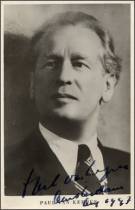
Paul van Kempen (16 May 1893 – 8 December 1955) was a Dutch conductor.
Van Kempen was born in Zoeterwoude, Netherlands, and later studied at the Amsterdam conservatory from 1910 to 1913, including composition and conducting with Julius Roentgen and Bernard Zweers, as well as violin with Louis Zimmerman. From 1913, he was a second violinist with the Concertgebouw Orchestra, and one year later, was in the first violin section. After 1916, he began to make his career more in Germany, and served as concertmaster in orchestras in Posen, Bad Nauheim und Dortmund.
In 1932, van Kempen became a German citizen. He was music director in Oberhausen for 2 years. From 1934 to 1942, he was principal conductor of the Dresden Philharmonic. In 1942, he succeeded Herbert von Karajan as Kapellmeister in Aachen, serving through 1944. Several years after World War II, in 1953, van Kempen became general music director of the city of Bremen.
In 1949, van Kempen returned to the Netherlands as principal conductor of the Netherlands Radio Philharmonic Orchestra, based in Hilversum. However, his conducting activities during World War II made him a controversial figure in the Netherlands, such as conducting concerts for the Wehrmacht. On one occasion, in 1951, van Kempen was engaged as a substitute conductor at the Concertgebouw Orchestra in place of the ill Eduard van Beinum. During the first night, audience members protested strongly, but the concert took place. On the second night, the audience disruptions were so severe that 62 musicians left the stage and refused to continue.
Van Kempen recordings included the Beethoven Symphonies Nos. 3, 7 and 8, the five Beethoven piano concertos with Wilhelm Kempff, and the Tchaikovsky Symphony No. 6. He died in Amsterdam at age 62.
Ludwig van Beethoven
Symphony no 3 in E flat major, Op. 55 "Eroica"
Symphony no 7 in A major, Op. 92 Berlin Philharmonic Orchestra 1950's
Symphony no 5 in C minor, Op. 67
Dresden Philharmonic Orchestra
1941
Paul van Kempen
| 
